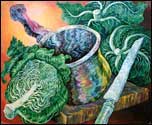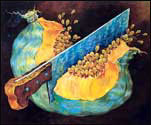|
Home . Gallery . Review . Commentary . C.V. . Email . Exhibtions |

The Persuasion of the Real
Michael Dunn 1995
The domestic world conjured up by Sylvia Siddell is one where still-life objects take on a pulsating energy full of movement and unease. Everyday implements such as a bread knife, become threatening images of death or mutilation. Siddell's domestic world seems restive and subversive of accepted values. The scale and colour of her still-life objects depart from normal expectations and enter into a realm of psychological malaise where the normal order is overthrown. It is easy to trace a feminist agenda in Sylvia Siddell's paintings that looks inward to the traditional arenas of women's work such as the kitchen, with feelings of anguish and repulsion rather than contentment. But whether she would paint any differently no matter what the subject-matter, is conjectural, for her reality is one in which the imaginative dimension would always be to the fore and movement very much part of her visual dynamic.
Conté
920 x 690mm
Collection Robert McDougall Gallery Christchurch
Contemporary Painting in New Zealand
Initially Sylvia Siddell was known for her highly personal, expressive drawings. In these works on paper she introduced the contortions and exaggerations of form which contribute the essential character of her vision. Her drawings and paintings are all figurative in type, with clearly recognisable subjects drawn from the domestic sphere of home and family. Far from celebrating the order and peace of the home, though, Siddell's works suggest an unease both psychological and physical. In this respect there are parallels with the treatment of domestic themes by the painter Philip Clairmont, whose work she knows. Unlike Clairmont, though, Sylvia Siddell presents a feminist stance in which the constraints of being a housewife can be seen as leading to frustration and potential violence.
Gradually Sylvia Siddell turned more towards painting as a medium to convey her ideas. In the 1990s much of her most important work has been in acrylic on canvas, the introduction of colour having allowed her to heighten the effects of disquiet and trauma her images evoke. Typically in her new canvases the kitchen is the setting for scenes of simulated violence where the preparation of food becomes an intense psychological drama. Beheaded, 1994, for example, shows three cabbage heads, one of which has been cut in half by the knife that lies prominently across the foreground. The pot is empty but at the ready for further violating of the defenceless vegetables. In such works Siddell suggests the daily processes of death and consumption necessary to sustain life. Seethe, 1994, goes further, with a fish seemingly gasping for life in a frying pan and the elements of the stove becoming writhing snakes which reach out from their containers to threaten the viewer.
By choosing the domestic still life as her main subject area, Sylvia Siddell follows a path much trodden by women artists; yet she departs from many of the comforting myths still-life painting usually sustains. In the conflicts that her imagery so well conveys can be found autobiographical references to her own situation, caught between various roles, free to follow her art while still bound to the demands and duties of the conventional housewife.
Michael Dunn 1996

Acrylic on canvas
760 x 900mm
Private Collection
A survey show of the varied uses of realism in contemporary NZ art 1996
Staging the Real
To some degree all visual art is imitation. Through a series of decisions an artist chooses to depict or reproduce an idea. In the case of the works in the present exhibition this process is achieved with varying degrees of pretence at reality. What we view is often the replication of something that never did exist, and often could not have. These artists are involved in staging the real.
As viewers we are subject to the artist's choice of what is real. We accept as realistic this presentation as we view the image. The framing of an image is usually overlooked and it is only through questioning that we begin to wonder on the selection. Visual simulation of realism is as much about what is left out of the image as what is left in.
New Zealand has a history of artists working with differing realisms for visual ends. For example, works by C.R Goldie, A.H. O'Keefe, W.A. Sutton, Rita Angus, Michael Smither, and Don Binney can all been termed 'realist', although, more could be written about the differences between these artists than their similarity. In New Zealand there is no coherent sense of a 'movement' of 'Realists'. In fact, application of this term is inappropriate as it refers to a specific social and political moment in time. In the present survey exhibition New Zealand artists are shown to explore varied uses of realism. We encounter artists questioning the real, and exposing a subjective realism founded on memory, association and invention. Neither representation nor appearance are simple or static in these works. The visual image appears before us as the transcription of experience.
Contemporary New Zealand artists are using the real to explore representation, which in today's climate is a political act. Uses of the real determine at their broadest that the image is representational rather than abstract. The artist's intention is to depict reality conceptually. The act of depiction renders three dimensional the sculptural and pictorial space. Although , as the saying goes, the map is not the territory, these maps can be seen to reflect some of the realities of the territory.
The domestic kitchen is the subject of Sylvia Siddell's Divided in which a sliced pumpkin bleeds pips. Siddell references the violent actions of a kitchen in the style of a European vanitas painting. The threat and inevitability of time passing and the speed at which life can be altered, (with the cut of a knife) are both addressed. This is not a purely negative viewpoint, for it is with this preparation that food becomes desirable. The passing of time looks toward a re-birth of some form.
Susan Ballard

Acrylic on canvas
760 x 900mm
Collection Auckland Art Gallery Toi O Tamaki